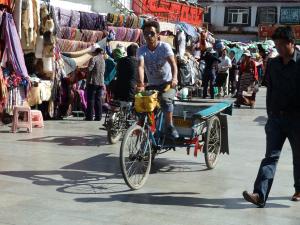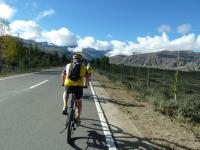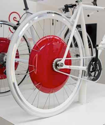By Karen Kefauver
September 21, 2012
Link to Sentinel Article
 The United Nations’ World Tourism Organization predicts that China will become the world’s most popular travel destination in the next four to six years. I’m glad I got a jump start on that trend by visiting China for the first time last fall. After all, I wouldn’t want to blend into a big crowd of tourists when I visited the country with a population of 1.3 billion and growing.
The United Nations’ World Tourism Organization predicts that China will become the world’s most popular travel destination in the next four to six years. I’m glad I got a jump start on that trend by visiting China for the first time last fall. After all, I wouldn’t want to blend into a big crowd of tourists when I visited the country with a population of 1.3 billion and growing.
It was my first trip to China and I didn’t know anyone else who would be going. So, I took the plunge by signing up for a three-week expedition with Davis-based Imagine Tours. The big attraction for me was that the trip included bike riding, as well as travel by bus, plane and train. Bicycling in China seemed
During a three-week cycling trip through China, the roads of Tibet offered a peaceful reprieve from the cars, motorcycles and construction of Beijing. (Karen Kefauver/contributed)
like it would make enduring the longest airplane flight of my life to date worthwhile [It’s 12 hours from San Francisco to Beijing].
 The highlight, however, turned out to be Tibet. It was a three-day stop in an itinerary that included multiple Chinese provinces.
The highlight, however, turned out to be Tibet. It was a three-day stop in an itinerary that included multiple Chinese provinces.
In general, one of the most astonishing things I observed throughout China was the abundance of construction. Seemingly everywhere, bridges, buildings and roads were being built by throngs of men and women workers. That made bicycling through and exploring some of Tibet’s amazing countryside — near Lhasa, the capital, and Shannan, a city southeast of Lhasa — feel like I was taking a step back in time, and the slower pace of life was a welcome change.
I’m even more grateful now that peace and Tibet have a rockier relationship.
In June, news organizations reported “Tibet was closed” to foreign visitors until at least mid-July as a result of protests and unrest. China reopened the country’s borders with stricter regulations for a brief period. Yet according to a Sept. 14 Examiner story, the foreign tourists are now once again being kept out of Tibet.
My earliest recollection of political problems in the region was seeing “Free Tibet” bumper stickers on cars when I was kid. Back then, I didn’t understand what they meant. Now, I understand that many who live in Tibet, including many followers of the Dalai Lama, feel they are driven to take extreme measures because they cannot tolerate Beijing’s strict rule over local religion and culture.
For travelers, it means you may or may not get to visit.
In order for our group to visit Tibet, special permits were required. Our two guides, Nancy Redpath, owner of Imagine Tours, and our Chinese guide, He Zhi Qin [“Mr. Ho”] of Grand China Bike Tours, were able to arrange the permits. Redpath has been working with Mr. Ho since 1998 and plans to run another trip to China this fall.
It’s worth the struggles and patience to get there.
Lhasa was breathtaking, literally, at an elevation of 11,450 feet. A highlight was bicycling from our hotel to the Potala Palace, a world-famous site. It has been the winter palace of the Dalai Lama since the 7th century and symbolizes Tibetan Buddhism and its central role in the traditional administration of Tibet. The sprawling complex includes towering White and Red palaces on top of Red Mountain in the center of Lhasa Valley.
There were not bike racks outside the palace, so instead we parked our pack of bikes in a nearby guarded parking lot. Then we leisurely toured the palace. I felt connected spiritually with the Tibetan people, thousands of whom were visiting the holy palace alongside us.
Overall, my favorite part of being in Tibet was getting on the bike and leaving behind that bustling capital city, which was far larger than I had imagined. In Beijing, I had discovered that the days of streets filled with bicycles was a bygone era. The modern reality is that cars and motor scooters dominated the roads. Bikes still have a place, at the riders’ peril as the lowest rung of the transportation food chain.
Yet, on the bright side, as cyclists find all over the world, when you encounter locals on a bike, you are more likely to get a smile, a wave or a curious stare than if you are traveling in a car.
This was the case when our group left the city of Lhasa, then bicycled a leisurely 60 kilometers along the middle and lower reaches of Yarlung Tsangpo River towards the city of Shannan.
Along the way, I studied the distinctive Tibetan architecture on homes, temples and schools. I admired the colorful woven clothing of women with babies strapped to their backs and gazed at the Tibetan prayer flags blowing in the wind from rooftops and yards. Steep mountain ranges rose from the horizon. I was grateful our ride was hilly but not too demanding; the high elevation made it tough enough.
At one small village, I took off my helmet and waved at the shy but gleeful kids in the front yard of a stone house. They squealed and ran inside. Just as quickly they returned followed by a group of women. Though we shared no common language, we smiled and waved as I got back on my bike and continued on my journey. I felt a connection and credited my cycling for helping break down cultural barriers.
As China continues to grow and change, I hope the old ways don’t vanish altogether. I also hope that bicycling, at least, will remain a wonderful way for tourists and locals alike to bridge the gap between past and present and connect with one another.


